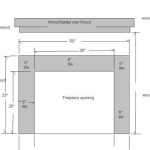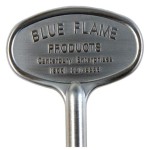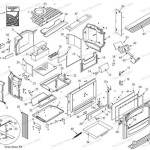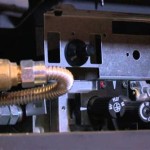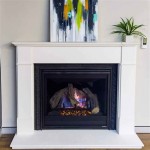Outdoor Ventless Fireplaces: A Comprehensive Guide
Outdoor ventless fireplaces offer a captivating and convenient way to enhance outdoor living spaces, providing warmth and ambiance without the need for traditional venting systems. These fireplaces are designed to operate without a chimney or flue, making them a versatile and accessible option for homeowners seeking to extend their enjoyment of patios, decks, and gardens throughout the year. Understanding the technology, safety considerations, design options, and maintenance requirements of outdoor ventless fireplaces is crucial to making an informed decision and maximizing their benefits.
The core principle behind ventless fireplace operation lies in their efficient combustion process. They rely on burning fuel completely and cleanly, minimizing the production of harmful emissions like carbon monoxide. This complete combustion is achieved through precise engineering and design, incorporating features such as oxygen depletion sensors and catalytic converters. These components ensure that the fireplace shuts off automatically if oxygen levels drop to unsafe levels or if incomplete combustion occurs, preventing the release of dangerous gases into the surrounding environment.
Fuel options for outdoor ventless fireplaces typically include propane and natural gas. Propane models utilize refillable tanks, offering portability and flexibility in placement. Natural gas models, on the other hand, require a connection to a natural gas line, providing a continuous fuel supply. The choice between propane and natural gas depends on factors such as the availability of a natural gas connection, the desired level of portability, and personal preferences regarding fuel management.
The installation process for outdoor ventless fireplaces is generally simpler compared to traditional wood-burning fireplaces, primarily due to the absence of venting requirements. However, proper installation remains paramount to ensure safe and efficient operation. It is highly recommended to engage qualified professionals for installation, particularly when dealing with gas connections. Professionals can assess the suitability of the chosen location, ensure proper connections, and conduct thorough testing to verify the fireplace functions correctly and safely. Compliance with local building codes and regulations is also crucial during the installation process.
Key Point 1: Understanding the Safety Mechanisms
Safety is the foremost concern when considering outdoor ventless fireplaces. The absence of a venting system necessitates robust safety features to prevent the accumulation of harmful gases. Two primary safety mechanisms are oxygen depletion sensors (ODS) and catalytic converters.
Oxygen depletion sensors constantly monitor the oxygen levels in the surrounding area. If oxygen levels drop below a predetermined threshold, indicating incomplete combustion or inadequate ventilation, the ODS automatically shuts off the gas supply to the fireplace, preventing the release of carbon monoxide. This feature is crucial for preventing carbon monoxide poisoning, an odorless and potentially fatal hazard.
Catalytic converters, on the other hand, play a role in reducing emissions by converting carbon monoxide into carbon dioxide, a less harmful gas. These converters contain a catalyst, typically platinum or palladium, that facilitates the oxidation of carbon monoxide at relatively low temperatures. While catalytic converters significantly reduce carbon monoxide emissions, they do not eliminate them entirely. Therefore, the ODS remains a critical safety component, even in fireplaces equipped with catalytic converters.
In addition to ODS and catalytic converters, other safety features may include tip-over sensors, which shut off the fireplace if it is accidentally knocked over, and flame failure devices, which stop the gas flow if the flame is extinguished. Regular inspection and maintenance of these safety features are essential to ensure their continued effectiveness.
While ventless fireplaces incorporate these safety mechanisms, adequate ventilation is still important. Although they don't require a chimney, they should be used in open or well-ventilated outdoor areas to further minimize any potential risks. Avoid using them in enclosed spaces, as this can lead to the buildup of carbon monoxide and other harmful gases.
Key Point 2: Design and Aesthetic Considerations
Outdoor ventless fireplaces are available in a wide array of designs, styles, and materials, allowing homeowners to seamlessly integrate them into their existing outdoor decor. From modern and minimalist designs to rustic and traditional styles, there is a ventless fireplace to suit every taste and aesthetic preference.
Common design options include freestanding fireplaces, wall-mounted fireplaces, and fire pits. Freestanding fireplaces offer flexibility in placement and can be easily moved as needed. Wall-mounted fireplaces create a focal point on a wall or fence, saving space and adding a touch of elegance. Fire pits provide a more communal and interactive experience, encouraging gatherings around the flickering flames.
Materials used in the construction of outdoor ventless fireplaces vary widely, including stainless steel, stone, brick, and concrete. Stainless steel offers durability and a modern aesthetic, while stone and brick provide a more rustic and natural look. Concrete fireplaces can be customized with various finishes and textures to complement any outdoor setting. The choice of materials depends on the desired aesthetic, the overall style of the outdoor space, and budget considerations.
Furthermore, decorative elements such as lava rocks, ceramic logs, and glass beads can be added to enhance the visual appeal of the fireplace. These elements not only add texture and depth but also help to distribute the heat more evenly. The flame characteristics can also be adjusted to create different ambiance, from a gentle flickering flame to a roaring fire.
Consider the size and scale of the outdoor space when selecting a ventless fireplace. A large fireplace may overwhelm a small patio, while a small fireplace may be insufficient to provide adequate warmth in a larger area. Choose a fireplace that is appropriately sized for the space and complements the surrounding landscape.
Key Point 3: Maintenance and Operational Best Practices
Proper maintenance is crucial for ensuring the longevity, safety, and efficient operation of outdoor ventless fireplaces. Regular cleaning, inspection, and timely repairs are essential to prevent malfunctions and extend the lifespan of the appliance.
Cleaning the fireplace involves removing dust, debris, and soot from the burner, logs, and surrounding surfaces. Use a soft brush or cloth to clean the exterior surfaces and a vacuum cleaner to remove debris from the burner area. Avoid using harsh chemicals or abrasive cleaners, as these can damage the finish and components of the fireplace.
Inspect the gas connections, hoses, and valves regularly for leaks and damage. Use a soapy water solution to check for leaks by applying it to the connections and looking for bubbles. If any leaks are detected, turn off the gas supply immediately and contact a qualified technician for repairs.
The oxygen depletion sensor (ODS) should be inspected and tested periodically to ensure it is functioning correctly. Refer to the manufacturer's instructions for specific testing procedures. If the ODS is not working properly, it must be replaced immediately to prevent the risk of carbon monoxide poisoning.
The catalytic converter, if equipped, should also be inspected regularly for clogs or damage. A clogged catalytic converter can reduce the efficiency of the fireplace and increase emissions. Clean or replace the catalytic converter according to the manufacturer's recommendations.
When operating the fireplace, always follow the manufacturer's instructions and safety guidelines. Never leave the fireplace unattended while it is in operation. Keep flammable materials away from the fireplace to prevent fire hazards. Ensure adequate ventilation in the area surrounding the fireplace.
Proper storage of propane tanks is also essential for safety. Store propane tanks in a well-ventilated area away from direct sunlight and heat sources. Avoid storing propane tanks indoors or in enclosed spaces. Disconnect the propane tank from the fireplace when it is not in use.
By adhering to these maintenance and operational best practices, homeowners can ensure the safe, efficient, and long-lasting performance of their outdoor ventless fireplaces, maximizing their enjoyment of outdoor living spaces throughout the year.
In addition to the above listed points, ensuring the proper fuel is selected to the ventless fireplace is a critical component to consider. Never use fuels other than what the manufacturer recommends, even if they appear to burn similarly. Each fuel has different combustion characteristics, and unapproved fuels could damage the unit or lead to the release of dangerous emissions.
Even though these units are ventless and designed for outdoor use, it is still crucial to consider the placement of your fireplace in relation to structures such as houses and pergolas. Make sure to maintain a safe distance to avoid any potential heat damage to surrounding materials. Understanding the heat output of the unit will assist in finding the best possible location.

White Mountain Hearth By Empire Ventless Outdoor See Through Gas Fireplace 60

Empire Outdoor 42 Inch Vent Free Fireplace With Electronic Ignition Op42fp72m Hvacdirect Com

Empire 42 Outdoor Ventless Firebox All Stainless Fine S Gas

Courtyard 36 Ventless Fireplace Premier Grilling

42 Outdoor Gas Fireplace Electronic Ignition Fine S

Majestic Courtyard 36 Inch 42 Vent Free Outdoor Natural Gas Firep Fyre Direct

White Mountain Hearth By Empire Ventless Premium Outdoor Gas Firebox 42

Superior Vre4300 Custom Series 42 Outdoor Vent Free Natural Gas Fireplace Firebox

Superior Outdoor Vent Free Gas Firebox Vre6000

Superior 72 Inch Linear Vent Free Outdoor Gas Fireplace Vre4672 North Country Fire
Related Posts

